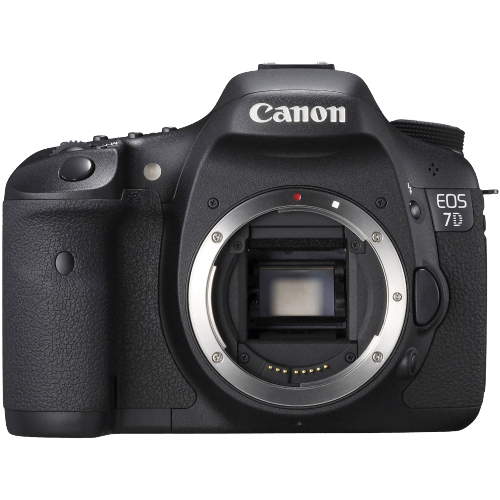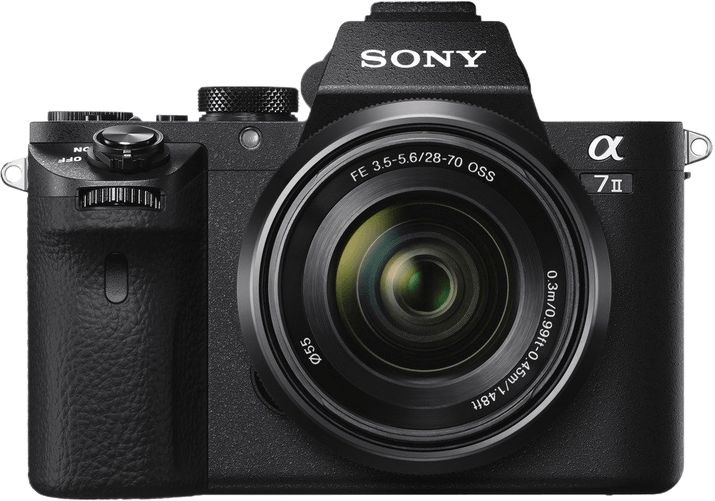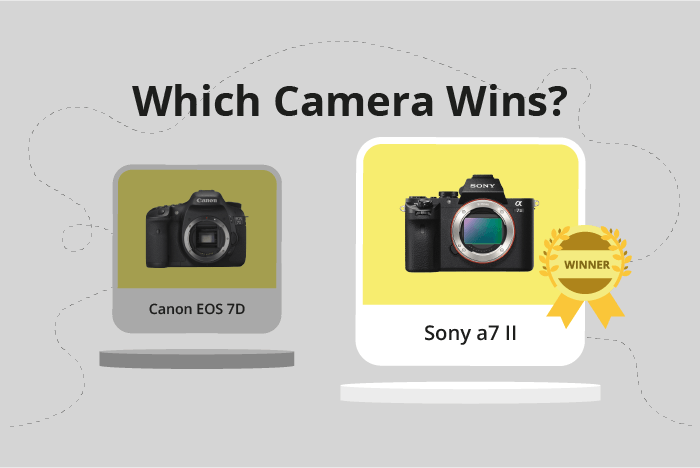Canon EOS 7D vs Sony a7 II Comparison
Canon EOS 7D

Sony a7 II

The Sony a7 II outperforms the Canon EOS 7D with a score of 69/100 compared to the latter’s 45/100. Both cameras were released in the 2009-2014 period, with the Canon EOS 7D being a DSLR and the Sony a7 II a mirrorless camera. They share similarities in their launch prices, with the Sony a7 II being slightly more affordable at $1600, while the Canon EOS 7D launched at $1974.
The Sony a7 II excels due to its lighter weight of 599g and compact size of 127 x 96 x 60mm, making it more portable and user-friendly. On the other hand, the Canon EOS 7D weighs 860g and has dimensions of 148 x 111 x 74mm. Despite its larger size and weight, the Canon EOS 7D’s DSLR nature may be preferred by some traditional photographers.
Taking all factors into account, the Sony a7 II emerges as the better option due to its higher score, affordability, and compact design. However, the Canon EOS 7D may still appeal to those who prefer DSLR cameras.
Canon EOS 7D vs Sony a7 II Overview and Optics
The Sony a7 II triumphs over the Canon EOS 7D in optics, scoring 78/100 compared to the Canon’s 43/100. Both cameras possess a CMOS sensor, but the Sony a7 II has a higher megapixel count at 24.2, while the Canon EOS 7D has 18 megapixels. The shooting speed of the Canon EOS 7D is 8, whereas the Sony a7 II has a shooting speed of 5. Both cameras have their unique processors – the Canon EOS 7D has a Dual Digic 4 processor, while the Sony a7 II utilizes a Bionz X processor.
The Sony a7 II boasts a superior DXOMARK sensor score of 90, compared to the Canon EOS 7D’s score of 66. Additionally, the Sony a7 II has a full-frame sensor size, while the Canon EOS 7D uses an APS-C sensor. The lens mounts differ as well, with the Sony a7 II having a Sony E lens mount and the Canon EOS 7D using a Canon EF-S lens mount. The Sony a7 II also offers image stabilization, which the Canon EOS 7D lacks.
Despite the lower optics score, the Canon EOS 7D has a faster shooting speed than the Sony a7 II, which may be advantageous in certain situations. However, the overall optics performance of the Sony a7 II is superior, offering higher image quality, better sensor performance, and image stabilization. The Canon EOS 7D falls short in these areas, which contributes to its lower optics score.
The Sony a7 II is the clear winner in terms of optics, with its higher megapixel count, superior sensor size, and image stabilization. While the Canon EOS 7D has a faster shooting speed, it does not outweigh the advantages of the Sony a7 II’s optics capabilities.
Canon EOS 7D vs Sony a7 II Video Performance
The Sony a7 II emerges as the superior camera in terms of video capabilities, with a score of 56/100 compared to the Canon EOS 7D’s score of 43/100. Both cameras share some common specifications, such as offering Full HD video resolution and lacking built-in time-lapse functionality. However, there are key differences that set the Sony a7 II apart and contribute to its higher score.
The most notable advantage of the Sony a7 II is its higher maximum video frame rate of 60fps, which is double the 30fps offered by the Canon EOS 7D. This allows the Sony a7 II to produce smoother and more realistic motion in video recordings, making it a more suitable choice for capturing fast-moving subjects or creating slow-motion effects.
While the Canon EOS 7D does not outperform the Sony a7 II in any specific video-related aspects, it is still a capable camera for recording Full HD videos at 1921 x 1080 dimensions. This makes it a viable option for casual videographers or those on a tighter budget, as the Canon EOS 7D is generally more affordable than the Sony a7 II.
Taking into account the key differences in video capabilities, the Sony a7 II is the clear winner in this comparison. Its higher video score and 60fps maximum frame rate make it more suitable for demanding videography tasks or professional use. The Canon EOS 7D, while not as impressive in this regard, remains a decent option for casual video recording or budget-conscious users.
Canon EOS 7D vs Sony a7 II Features and Benefits
The Sony a7 II outperforms the Canon EOS 7D with a feature score of 57/100 compared to the Canon’s 54/100. Both cameras share several common specifications, including a 3-inch screen, the absence of a touchscreen, GPS, and Bluetooth. However, the Sony a7 II has advantages over the Canon EOS 7D in certain areas, while the Canon EOS 7D also has its own strengths.
The Sony a7 II excels in screen resolution and usability, with a resolution of 1,230,000 dots, significantly higher than the Canon EOS 7D’s 920,000 dots. This results in a clearer and more detailed display on the Sony a7 II. Additionally, the Sony a7 II features a flip screen, enhancing its versatility in various shooting angles and situations. The camera also includes WiFi capability, allowing for easier transfer of files and remote control of the camera.
On the other hand, the Canon EOS 7D does not have any distinct advantages over the Sony a7 II in terms of features. Both cameras lack a touchscreen, GPS, and Bluetooth, and the Canon EOS 7D falls short in screen resolution and usability compared to the Sony a7 II.
Taking these points into consideration, the Sony a7 II proves to be the better option due to its higher screen resolution, flip screen, and WiFi capabilities. While the Canon EOS 7D may still be a viable choice for some users, the Sony a7 II offers more advanced features, making it the preferred camera in this comparison.
Canon EOS 7D vs Sony a7 II Storage and Battery
The Canon EOS 7D and Sony a7 II are neck to neck in storage and battery. Both cameras share similarities, possessing one memory card slot and lacking USB charging capabilities.
The Canon EOS 7D outperforms the Sony a7 II in battery life, providing 800 shots per charge, while the Sony a7 II only offers 350 shots. Moreover, the Canon EOS 7D accepts Compact Flash (Type I or II), UDMA, and Microdrive memory cards, making it more versatile in terms of storage.
Though the Sony a7 II scores lower, it still supports SD/SDHC/SDXC and Memory Stick Duo/Pro Duo/Pro-HG Duo memory cards, accommodating a wide range of commonly used storage formats.
Considering these factors, the Canon EOS 7D emerges as the superior option in terms of storage and battery performance, while the Sony a7 II remains a decent choice with its varied memory card compatibility.
Canon EOS 7D vs Sony a7 II – Our Verdict
Are you still undecided about which camera is right for you? Have a look at these popular comparisons that feature the Canon EOS 7D or the Sony a7 II:

